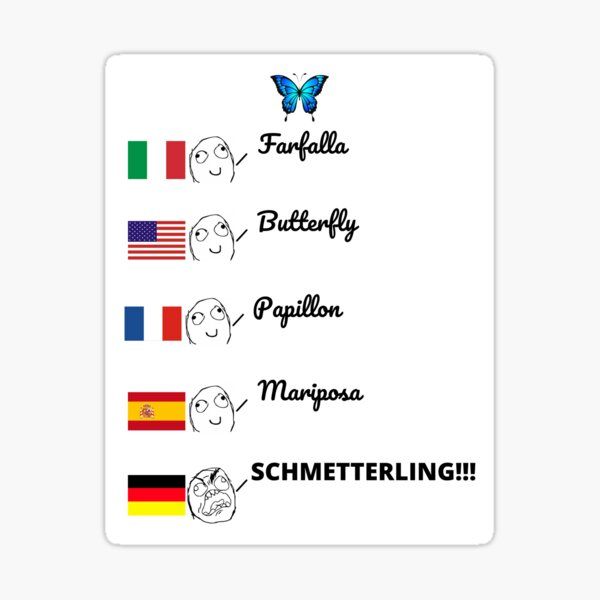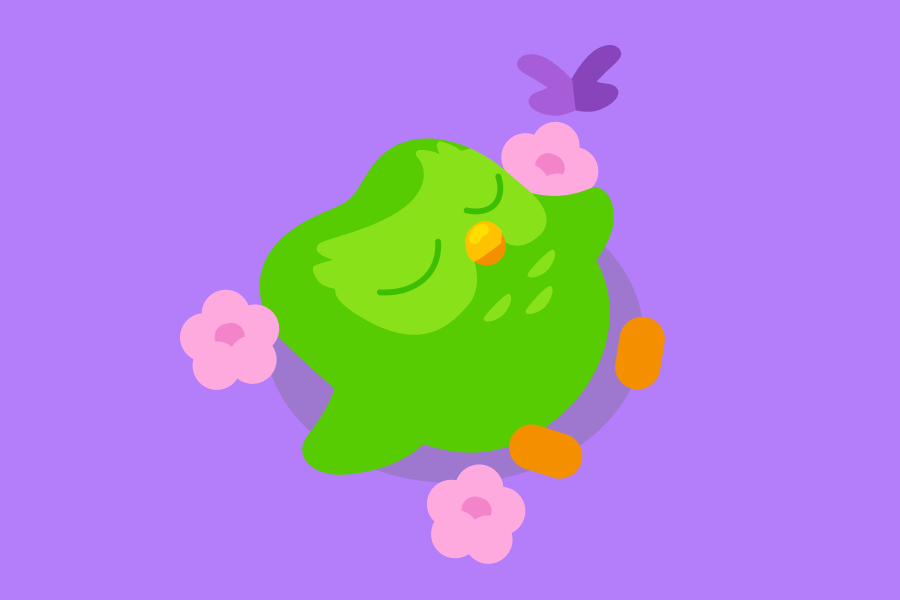The great Dolly Parton sang that love is rare and gentle, just like the butterfly. These creatures capture our attention as children, tracing their life cycles from lowly caterpillars to beautiful winged adults. They've made their way into our language, too: We get them in our stomachs on first dates, and we *flutter* our eyelashes and give butterfly kisses.
But the elegance of the butterfly doesn't seem to translate across languages!
How do you say "butterfly" in German?
Many consider the words for "butterfly" in the Romance languages sweet, even poetic: It's farfalla in Italian, papillon in French, and mariposa in Spanish. But the German word for "butterfly" has risen to the level of the meme: Schmetterling.

Apparently, the general consensus is that Schmetterling is totally unfit to represent the graceful butterfly: It's too harsh, too long, too angry-sounding—not so different from other memes about the entire German language!
But who decides what counts as sounding harsh, angry, or ugly? All the sounds in the word Schmetterling also exist in English, even if we don't usually combine them this way. (We do sometimes, in borrowings from Yiddish!) So where does this idea come from, and why does the English word "butterfly" get to escape the ridicule?
These feelings we have about language are called language attitudes. We hear someone say something, we identify them as belonging to a particular group (maybe based on gender, age, race, ethnicity, or religion), and then we assign them a stereotype that gets linked to their language, too. So, when we hear Schmetterling alongside French papillon and Spanish mariposa, we actually think of German speakers, French speakers, and Spanish speakers—and many think of Germans as the harsh, rigid, ugly speakers of a hard, rigid, and ugly language.
Attitudes certainly aren't universal, and they instead reflect our prejudices. Not everyone will have your perspective on what "sounds" sweet or elegant when it comes to language! Sadly, language attitudes can contribute to discrimination and breakdowns in cultural understanding, especially when they are directed at racial and ethnic minority cultures.

The story of "butterfly" in German and English
There's a lot more to a word's beauty than its pronunciation (and how you personally perceive it!).
Schmetterling is a great example. It (likely) comes from a Slavic word, smetana (cream), that was borrowed by German-speaking people centuries ago. A butterfly was a little "cream-ling"! Think earthling... but for cream. In that sense, Schmetterling is actually a lot like the English word butterfly. 💡
We know that English and German are related languages, but what's this butterfly connection to dairy products? There's no shortage of possible answers to that question—here are the most popular:
- the color of cream and butter is similar to the soft yellow of some butterfly wings
- butterflies emerge at the time when butter was traditionally made in the countryside
- butterflies flutter over fields when they are full of buttery yellow blooms
- witches, disguised as butterflies, stole milk, cream, and butter (!)
The witch thief theory is by far my favorite because it comes from an old folk tradition that shows up in many German dialects and legends. For example, dialects of Central German (like the German spoken in Hessen and Thuringia) call some butterflies Milchdiebe—literally "milk thieves"!
But wait… why are witches so interested in milk?
From butterflies to shooting milk
Historically, stealing milk was a common crime used to bring so-called witches to trial in early modern Europe. The liquid of life itself, they reasoned, would be something of value to a witch — and, of course, to anyone who was malnourished and targeted as a "witch."
In my own Pennsylvania Dutch culture (a culture that traces back to the Rhenish Palatinate region of Germany), witches can bewitch your cream so that it doesn’t churn over into butter. The remedy? Drive out the witches by stabbing the liquid with a knife, by plunging a hot iron into it, or by shooting it with a shotgun!
So, some naysayers on the internet may not appreciate the sweetness of Schmetterling, but what I hear is its deeply cultural and storied history extending across a millennium of human history, cultural connections, and folklore. This history of just this one word gives us a far-reaching time machine into our past, to the very grass a cow eats to produce milk (and the little creatures fluttering above those pastures), and the cream that my people stab when it's verhext (bewitched).
All languages hide amazing stories behind simple words!
That's why language learning is so important, and so powerful: Language takes our curious minds into cultural realms we would never reach otherwise! And it gives us a way to reevaluate the language attitudes we hear around us.



